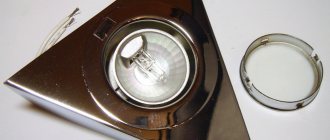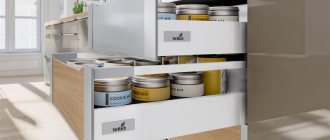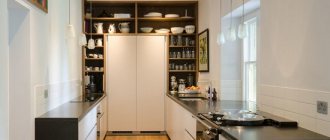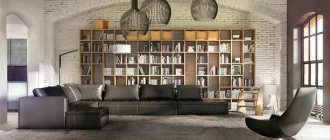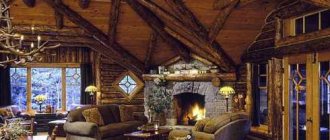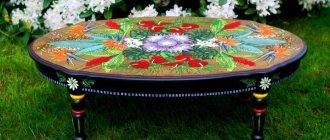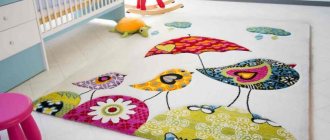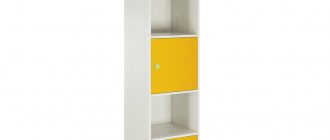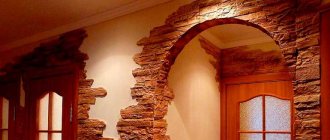This article will help you figure out whether you need lighting for the wardrobe you are planning to order. This seemingly simple question leads many customers to a dead end, since there are two completely opposing opinions regarding the usefulness of this function. Opponents of equipping furniture with lamps argue that they are intended only to decorate wardrobes, but in fact they are of no use, and their installation is just a waste of money. We will now try to figure out how right they are.
Indeed, sometimes this functionality turns out to be unnecessary. This usually happens when the cabinet has a shallow body and is located in a bright room, and such furniture is used mainly during the day. In such situations, there is no need to buy lamps for the wardrobe and pay for installation services. Also, you should not expect significant benefits from external lighting, since in 90% of models it performs only a decorative function. In all other cases, it is preferable to order a wardrobe with lighting, and we will now explain why:
1. Even if there is good artificial lighting in the room, there is still twilight inside the cabinet, which makes finding the right things difficult, and this already indicates an insufficient level of comfort in the wardrobe. Of course, over the past years we have become accustomed to furniture without internal lighting and are able to find any object almost by touch, but this is not an argument in favor of abandoning this function, but rather a feature of our mentality. It doesn’t hurt to remember practical Americans and Europeans, whose dressing rooms are flooded with bright light from the inside. The body of the sliding wardrobe is the same as a dressing room, only smaller in size, so the difference should only be in the intensity of lighting. At the same time, determining the required lamp power is the task of manufacturers; Stiver-100 solves this issue based on the volume of the departments and their degree of congestion.
2. In addition to increasing the level of comfort, time is saved thanks to the lighting of the wardrobe. At first glance, this statement may seem banal, but it is true - especially for furniture in the hallway, where models with sliding facades are most often ordered. In order not to be unfounded, we suggest considering the procedure for finding the right thing in this room. The first thing we do when we enter the hallway, even during the day, is go to the switch and turn on the lamps. Then we head to the closet, move aside the facade and, despite the light on in the room, we search for the desired item in the twilight, spending much more time on this. Now it doesn’t hurt to calculate the average number of times all household members approach this cabinet per day and multiply all the minutes spent on unnecessary actions by the average lifespan of such a model - 7-10 years. For an ordinary family of three, the total walking time from the switch to the furniture and back is plus or minus 10 days over the designated period of time. Therefore, it is much more logical and profitable to make sure that the light turns on inside the housing when the facade is opened and turns off when it is closed. We will describe how to achieve this in practice a little later.
3. Internal lighting of the wardrobe helps to maintain perfect order and take care of your health. Moreover, we are talking not so much about neatly folded stacks of T-shirts or underwear, but about hygiene. In a darkened case it is difficult to detect accumulations of dust and, what is even more important for models installed close to cold walls, the appearance of fungus or mold. There is no need to remind once again how harmful it is to your health to wear clothes that contain spores of such microorganisms. This argument may seem far-fetched to some, and it would not be worth writing about it if, when dismantling old furniture (mainly in hallways, the walls of which border the stairwell), our workers did not find a barely noticeable brown-gray color on the shelves and side racks plaque is the first sign of mold spreading. In a well-lit building, you can detect traces of harmful microorganisms and stop their development at the initial stage.
In addition to practical factors that speak in favor of sliding wardrobes with lighting from the inside, there is another equally weighty argument - the status and respectability of furniture with a lighting system. By the way, if we consider that we regularly, without hesitation, pay for countless functions in phones, computers and other audio and electrical household appliances, the existence of which we don’t even know, then the costs of equipping a wardrobe with lamps look more than justified against this background - You are guaranteed to use this function, and it is clearly not superfluous.
And one more, probably the most convincing argument in favor of installing a lighting system - some time after purchasing a new model without this function, some owners of such furniture try to make lighting in the wardrobe with their own hands. This suggests that they are not entirely comfortable using furniture without lamps, and they decided to independently correct the mistake made when purchasing. Only solving this problem on your own will not provide the result that the manufacturer can guarantee you.
Photo of lighting in the dressing room
Types of tapes and their selection
The main criterion by which you should select a lighting strip for the kitchen is its protection from moisture.
LED diodes can be used to illuminate kitchen backsplashes made of glass or stone from the back. They effectively diffuse light from miniature light sources
Moisture, condensation, and temperature changes are inevitable in the kitchen, and LEDs must withstand this. Today there are the following types of tape according to the type of protection of electronic elements:
- Open. They are not sealed, and moisture easily gets onto the contacts of the conductive path. This type of tape is designated IP33. They should not be used for kitchen lighting.
- One-sided. The top part, where the LEDs are located, is sealed with a silicone protective casing. The marking of this type of tape is IP65.
- Double sided. This is the best solution for the kitchen; it is completely sealed, because the light elements are covered with a plastic casing. Similar tapes are marked as IP67 and IP68.
Tapes with maximum moisture resistance are also suitable for outdoor lighting. They also withstand sea water perfectly and do not suffer from condensation in the temperature range from -30° to +85°C
Also, when choosing this lighting element, you need to pay attention to:
- Power. It is also called illumination power. This indicator depends on the number of diodes in the lighting area. The brightest strips include 120 lighting components per meter. Such tapes combine design and lighting functions. Slightly “weaker” in light, the tapes have 30-60 sources per 1 meter. These are often used only for decoration; they are used to decorate the kitchen interior.
- The strength of the glow is determined by the energy consumption of the tape, and it is in the range of 4.8-32 W/m.
Strips with minimal luminous intensity are suitable for interior decoration and for installation inside shallow drawers and cabinets
Selection options
When choosing LEDs for the kitchen, pay attention to the following characteristics:
- type of product;
- color scheme;
- level of protection against moisture;
- functionality and cost of the power supply;
- size and number of diodes;
- crystal structure.
Let's take a closer look at each characteristic.
LED strip structure
Before connecting the device to a power source, it is necessary to understand the design features of the selected device.
Note! LED strip is a strip with a flexible board. On one side of such a part there are transistors and LED elements. Contacts are also located here. During installation work, wires are soldered to them.
The lighting fixture must receive electricity through a rectifier (direct current). Between the outputs on the tape there is a black stripe and a scissors sign - this is the cutting line. The tape must be divided strictly along this tape, otherwise it will fail. The minimum area for separation consists of 3 LED light bulbs . A protective tape is applied to the reverse side of the strip. After removing it, the strip can be glued to the cabinet or any other surface.
This device can be connected to a 12 or 24 volt power source. Resistors are used to limit the current in the circuit. The width of the tape is from 8 to 20 mm, the maximum length of the product is 5 meters with a width of 2-3 mm.
Important ! A LED strip no longer than 5 meters is connected to one power supply. This is due to the resistance of the diodes.
A diode strip for kitchen lighting is connected to a rectifier. Its power must correspond to the real needs of LEDs. It is not recommended to break this rule.
Types of tapes
The following types of ice tapes can be found on the modern market:
- SMDs are popular compact devices with good performance. In such a device, diodes of rectangular or triangular shape are installed.
- DIP tapes are manufactured in the form of cylinders. Such devices are fixed in the end part of furniture and other structures. The bulbs are in a silicone shell, which protects them from exposure to high humidity.
When comparing both types of products, one should point out the advantages of DIP models. They bend at any angle in the desired direction.
Color solution
Diodes can be color or monochrome. The latter crystals emit yellow, white, blue, green and red light. The glow temperature of such devices is at the level of 2800-10000 K.
Color strips usually consist of triple light bulbs in the blue, red and green spectrum. Combining these colors makes it possible to obtain different shades. The devices under consideration have an increased cost compared to monochrome ones. For their normal functioning, a controller is needed. A remote control is used to control colors.
Moisture protection
The degree of moisture protection of lighting devices is determined by a special IP index. Products marked IP 33 have minimal protection from moisture; they are recommended to be installed in dry residential areas. The IP 65 index indicates tapes that are treated with silicone.
Maximum tightness is for models marked IP 67 and IP 68. Such lighting fixtures are treated with silicone on all sides. Tapes can be used not only in the kitchen, but also in the bathroom, as well as outside. The products are fixed in a metal box, which protects the crystals from overheating and possible burnout.
Number of diodes
The number of diodes on the tape depends on the specific type of device:
- for brand 3528 there are 60,120 or 240 crystals on each linear meter;
- for tape model 5050 – 60 or 120 diodes per meter.
Important ! The minimum permissible number of diodes per linear meter is 30 pieces. The more elements, the wider the band and the more intense the glow.
Crystal sizes
In addition to the letter designation, digital combinations are added to the product labeling. For example, the SMD 3528 model indicates the name of the chip and the width of the tape. Here the parameters are 3.5*2.8 mm.
On the market of LED strip lights, the most common products are labeled SMD5050, as well as SMD3528. Models with the digital designation 5730, 5060, and 5630 are slightly less popular.
A product labeled 3528 consumes a rated current of 6.7 mA. To trim the tape, a section with three diodes with a total rating of 20 mA is used. If we compare this model with the 5050 device, the glow intensity of the latter is 2.5 times brighter.
The size of the diodes is determined by the first digital designations in the product labeling. For model 3528, the overall dimensions of the LEDs are 3.5 * 2.8 millimeters, for strip 5050 - 5 * 5 mm, respectively.
power unit
The power of the power supply depends on the technical characteristics of the LED strip. To determine the power of this device, it is necessary to know the length of the strip and the energy consumption per linear meter of diodes. The power supply must be selected with a reserve; for this, a factor of 1.25 is added to the calculated power.
For example, you have a tape 5 meters long with a power of 12 watts per linear meter. We multiply these values and add the coefficient: 5 * 12 * 1.25 = 75 Watts.
Cable cross-section
To install an LED strip on a kitchen unit or in a kitchen work area, it is recommended to use wires with a diameter of 0.5-2.5 mm. The cross section is calculated using a special formula. The value of this parameter depends on the length of the wire and the power of the light bulbs.
Sources of light
A variety of lamps are used as lighting, which are presented in a wide range in specialized stores. Remember, the choice depends solely on your needs, taste, and individual preferences. Today, perhaps the most cost-effective, simple and quick way to create lighting in the kitchen is the use of LED strip; it tolerates moisture and dampness well, while meeting all the requirements for safety, functionality, and creating a cozy atmosphere. It is usually glued to the bottom of wall cabinets. You can use LED strip in all kitchens, regardless of the design of the room, since the lighting is unnoticeable due to its compact size.
Illumination of cabinets in the kitchen interior in raspberry color
Kitchen lighting under cabinets can be made in different colors. The blue, green, and white colors emanating from the lamp are considered relevant today.
Designer recommendations:
In order to create a cozy home environment, you should avoid using cold fluorescent light, which is often used in the office. In kitchens of small areas it is possible to exclude the central lamp, which, on the contrary, is not permissible for kitchens of large dimensions. It is necessary to plan kitchen lighting in advance, since the wiring of each zone is carried out before the finishing renovation work is completed. It is important to think in advance about the areas of the kitchen that should be illuminated. The choice of size and type of lighting depends solely on the importance of a particular kitchen area.
Lighting for kitchen cabinets is as indispensable as having a stove in the kitchen, since it will be very difficult for housewives to do without it at present.
Backlight options
LED lighting can be made from individual elements or a ready-made lamp.
- Overhead linear elements . Sold individually or in modules. The connection is made using a special adapter, which makes it possible to obtain a lamp of any length.
Overhead spotlights . Ready-made lighting fixtures.
Touch LEDs . The touch switch can have linear and point LEDs. To turn it on and off, just touch a certain point on the lamp body, indicated by a blue LED.
Recessed spotlights and surface-mounted lamps. Kitchen lamps for under cabinets are mounted on the bottom shelf.
LED strips . A set of colored LEDs is convenient because it is a ready-made lamp, the length of which can be any (you can cut off a section of the tape).
Location of lamps in the kitchen:
- Under wall cabinets . Lighting direction down. The lighting of the work area in the kitchen should be maximum.
Under the hood . The stove and the work surface adjacent to it must have illumination no less than that above the sink. Lighting direction down.
- In glass doors of wall cabinets . The light is soft and diffused.
- Above the upper cabinets. The direction of the light flux to the ceiling.
- Under the countertop to illuminate the contents of the lower cabinets.
- Illuminated glass tabletop from the inside.
- Bar counter lighting.
- Luminous skin on the wall panel between the upper and lower cabinets. The lighting comes from inside and does not have a directional light flux. You can install a hanging chandelier in the kitchen.
Skinal is a decorative glass panel with photo printing and LED backlighting. To install a decorative apron, impact-resistant glass (5,6,8 mm), ice lamps or LED is required. Illumination can be done from the end or the back.
With edge lighting, LEDs are attached to the top and bottom edges of the glass using an aluminum profile. The illumination option from the rear side is carried out by installing LEDs behind glass, in a specially prepared niche. In the first case, the lighting will be more uniform. In the second option, the brightest area is the location of the diode.
But what types of kitchen sets there are, you can see here.
Depending on the color of the skin, the shade of the glass is selected:
- bleached Optiwhite for white;
- regular tempered glass for colored glass.
Basic rules for installing backlight:
- Upward light is brighter than downward light. May be colored.
- The lower light, with the exception of work areas, should be softer and diffuse in nature.
- When highlighting a single-color skinnel, use RGV colored tape.
- The color panel is illuminated with a single-color warm or cool backlight.
To use RGV tape, you will need a remote control, which can be used to change the color gamut of the backlight.
How to make lighting in a closet with your own hands
The most popular lighting option for wardrobes is LED strip. Let's take a closer look at its installation.
The interior lighting of the sliding wardrobe can be additionally equipped with a motion sensor, as well as an ultrasonic sensor. Moreover, in the latter option, the lighting will work only after opening the cabinet door, and not when people are simply near it.
Interior lighting can be equipped with a motion sensor
To assemble the LED circuit and connect it to the power supply, it is recommended:
- Cut the required amount of tape at the appropriate location where the dotted line of the scissors indicates.
- Prepare a wire of the required cross-section. For a five-meter tape you need 1.5 mm. If the tape is longer, you will have to calculate it using the formula. And the connection diagram for such an LED will be more complicated. If you connect all the pieces in series with each other, individual segments can heat up.
- Use alcohol to degrease the LED contacts.
- Strip and tin the wires.
- Solder the red wire of the terminal to the “+” and the blue wire to the “-“. If you mix it up, the light won't come on.
- Use heat shrink tubing to insulate the solder joints. You can replace the heat shrink tube with a glue gun.
- Guided by the color coding, connect the wires of the LED strip to the power supply.
Let's start installing the tape:
- Measure the required length of tape. Moreover, this must be done in special places. Be careful.
- Where you need to mount the LEDs, attach a 10*10 mm plastic corner. It will allow you to hide the tape itself and will not spoil the appearance of the cabinet.
- Connect the wiring to the cabinet. To do this, you need to make a hole in an inconspicuous place. If each shelf is intended to be illuminated, an additional hole must be made in the corner so that the cable can be lowered lower along the cabinet.
- Place the cable ducts on liquid nails and hide the wire in them.
- Place the LED strip on the corner and turn on the power supply. After all, install the limit switches and the backlight is ready.
To avoid tearing out the chipboard when making a hole, it is recommended to immediately go 5 mm deeper inside. And then drill from the back of the sheet.
Before assembling the backlight, you need to sketch out the connection diagram. You can use not only LED strip, but also lamps in the housing
Fastening is carried out using self-tapping screws or glue
Having illuminated the closet, you will no longer need to use a floor lamp or lamp to illuminate the work surface and search for underwear on the shelf. And if you use high-quality devices and do everything according to our instructions, you will be able to enjoy the practicality of opening the door and the functionality of this type of lighting for a long time.
https://youtube.com/watch?v=dWoz6Ui7yX8
Furniture lighting installation
Table of characteristics of fluorescent lamps.
First you need to prepare the sockets for the lamps. To do this, it is wiser to remove the panel on which the lamps will be attached. Before forming holes, be sure to mark their location. Moreover, both on one and the other side of the furniture board.
Related article: Curtains with hinges: how to sew them yourself
The nest is drilled to a depth of 7-10 mm. Next, you need to turn the panel over and finish forming the hole on the other side. If this is not done and you drill right through, then there is a high probability of damaging the wardrobe part. Especially if your furniture is made of chipboard.
The lamps are installed in the sockets intended for them and connected to each other. In this case, it is wiser to use a parallel connection. Then one lamp that has become unusable will not disable all the lighting. The transformer is connected last.
All lighting elements are connected to each other using terminals or terminal blocks. Modern pads are an aluminum plate with contacts. Such features allow you to connect wires with aluminum and copper conductors.
This cabinet lighting is controlled using a switch. It can be located outside the wardrobe or inside it. Sometimes chains are used as a switch, which give the furniture an original look.
What are the advantages of LEDs
LEDs are some specific conductors that produce light when electricity is generated. The compositions may differ in chemical properties, which determines the brightness level of the light stream that they emit.
Lighting in a cabinet using LED strip is not always done directly. And all because the tape can overheat, or even crack over time. Therefore, a voltage stabilizer is needed.
Whatever tape you take, they have five-centimeter segments, each of which has three LEDs, and also has a special one. markings for easy cutting. The LEDs are first connected using a circuit.
LED lighting installation work
To illuminate your closet using an LED strip, you need to purchase:
- power supply (it can be replaced with an open type transformer) -
- strip with LEDs (if you buy an RGB strip, you will have the opportunity to customize the color of the lighting as you wish) -
- controller (now you can find cheap models that come complete with a control unit) -
- connecting terminals or blocks -
- electrical wire-
- fork.
When purchasing a tape controller, look for models with infrared meters. They can be controlled not only using a specialized unit, but also from a simple remote control designed for a TV. If you choose single-color diodes, then you will not need a control panel for the wardrobe lighting.
At the initial stage of installation work, you need to gradually connect all components into a common circuit. To do this, the supply wire is connected to the power supply. The controller is connected next.
As a rule, the wires intended to connect this component are quite thin and short. This makes them difficult to work with. And therefore, it is more correct to first clean them from the insulating coating, freeing the tips to a length of approximately 1 cm. To thicken the contacts, apply solder. Thanks to this simple action, the contact becomes much more reliable.
It is quite easy to attach the tape to the controller due to the fact that manufacturers mark the appropriate connections in different colors. In other words, you just need to combine wires of the same color together. You can combine them using terminals or soldering contacts. If you use soldering, do not forget to insulate the joints. If you decide to use terminals, add solder in advance. Otherwise, the contact may not be reliable enough.
Before the furniture lighting is completely installed, check out the LED strip by connecting it to the network. If you have used RGB diodes, test their performance in different light. If, for example, you are completely satisfied with the effect, then the tape can be glued inside the wardrobe. In most cases, it is fixed to the ceiling of the compartment and to the walls at the back. But part of the tape can be displayed on the front panel. Then your furniture will become an unusual design decoration.
Preparatory stage of installation
Previously, halogen lamps were often used to illuminate wardrobes. But their main drawback was that they got quite hot during operation. Therefore, it was possible not only to get burned by such a lamp, but also to damage the clothes stored in the closet. In addition, it is unsafe to use them, since modern furniture is made of flammable materials.
Therefore, fluorescent lamps or LED backlighting are now used. Such lamps remain cool even if the owners forget to turn off the lights.
You can install lighting only inside the wardrobe.
But furniture can also be illuminated from the outside by building lamps, for example, into the upper cornices.
Image 1. Backlight connection diagram.
Then this piece of furniture will also become a real decoration of the room.
Before starting work on installing the lighting, it is necessary to draw up a detailed connection diagram.
If you are not confident in your knowledge, then it is wiser to involve a specialist at this stage. An example of such a scheme is shown in Image 1.
In modern stores you can purchase ready-made kits designed for lighting furniture.
Usually the set includes from 3 to 5 lamps. But sometimes a standard set may not fit a particular cabinet according to some parameters. Then you will have to assemble the system yourself.
Related article: Metal bathtub
Required materials and tools
If you decide to use halogen lamps for lighting, then you definitely need to purchase a transformer. When choosing, you must consider the following parameters:
- Rated power. With its help, you can calculate the total power of the lamps that can be connected to this device. This means you can determine the number and personal characteristics of the lamps. But remember that the power of the transformer itself should be 5% greater than the sum of the power of the entire connected backlight.
- Output voltage. It should be equal to the operating voltage of the lamps that you want to use for the wardrobe.
- Transformer type (winding or electronic). When installing lighting for furniture, it is preferable to use option 2.
The device of a fluorescent lamp.
In addition to the transformer, you will need the following backlight components:
- electrical plug;
- wire (two-core cross-section 0.75);
- household switch;
- connecting terminals.
When planning lighting for the cabinet, remember that you should not use a wire longer than 3 m. Otherwise, power will be lost. When choosing a location for a transformer, do not forget that, unlike lamps, it heats up during operation. Therefore, it must be mounted at least 15-20 cm from the heat source. When calculating, it is also necessary to take into account central heating radiators, which are often located close to the walls of the wardrobe. Do not place the transformer in too narrow cavities.
To install the backlight you will need the following tools:
- screwdriver tester;
- a set of screwdrivers (it is wiser to prepare tools with flat and Phillips tips of different calibers);
- drill;
- special cutter attachment (crown).
The diameter of the cutter must match the internal diameter of the lamps. Otherwise you will have to widen the holes manually.
Lighting for the kitchen under the cabinets, light beams
Regarding light beams, only one thing can be said - these are somewhat outdated fluorescent lamps, which have recently been used extremely rarely. In fact, these are ordinary fluorescent lamps of a thin tubular design - they are relatively bulky and have practically no aesthetic appearance. True, recently small lamps of this type have appeared, which even look beautiful - they are up to half a meter long and, if necessary, can be connected to each other indefinitely. In principle, this is a good solution for the kitchen, but if you take into account their energy consumption, you can find something better - in general, an option for a solid four.
Installing such kitchen lighting under wall cabinets is quite simple to do it yourself. The only caveat is the power supply, which you will have to sort out a little. In principle, for these purposes you can also use a standard kitchen outlet located nearby - ideally it should be located behind the cabinets, since in this case the wires will not be visible. Also, such lighting can be powered from a kitchen hood, having previously equipped its connection point to the apartment electrical network with a standard socket. If you understand this point, then all the rest of the work will seem trivial to you.
- We take the first light beam and remove the shade from it, having first removed one of the side caps.
- We remove the fluorescent lamp and gain access to the holes for attaching the light beam.
- Now we simply install it in the right place at the bottom of the wall cabinets and fasten it with the small supplied screws.
- To top it off, connect the power cable to the light bar (from any side convenient for you) and insert the plug into the socket. If necessary, this wire can simply be extended.
If there is a need to connect two, three or more light beams into one circuit and thereby create full-fledged lighting for kitchen cabinets, then all subsequent beams are mounted in exactly the same way, with the exception of one nuance - each beam following the first is connected to the previous one using a small adapter , which is usually supplied with the product. First, we connect one beam to another, and then attach it to the wall cabinet. Everything is simple, clear and there are no unnecessary complications. This is one of those products whose ease of use is 100% taken care of by manufacturers.
How to make your own lighting in a wardrobe
This article will discuss how to install lighting in a closet. Sometimes we don't think about the fact that we might need a light in the closet when we buy a cabinet. But over time, it is difficult to do without additional lighting in the closet.
You constantly have to rearrange, put away, reconsider just to find the right thing. I think the situation is familiar to everyone.
As a rule, apartments have poor lighting, so very little light gets into the closet. To solve this problem, designers use many solutions.
These can be canopies in which lamps with or without motion sensors will be installed.
What are the cabinet lighting options?
Lamps with built-in motion sensors are installed so that the light turns on automatically when the cabinet doors are opened. Why bother turning the lamp on and off?
By the way, you can buy and install such lamps yourself, which will allow you to save money. Solutions and forms of lighting can be very different, depending on the needs.
Types of lighting:
- Mortise lamps, they save space and are quite economical. Such lamps are most often used in Shatura cabinets;
- Fluorescent lamps, they are used in large closets and dressing rooms;
- LED strips, such lamps are always easy to use, economical and will easily fit into any interior and cabinet shape;
- Also, in some cases, special control panels are used to control the light.
Before purchasing a cabinet, be sure to consider all possible light connection options.
Any type of lamps requires electricity, so first of all it is necessary to install the wiring to install the lamps.
EXAMPLE OF LIGHTING FOR A CLOSET WARDROBE
For an example of lighting a sliding wardrobe, we took a Steinel lamp with a built-in motion sensor. By the way, it is most convenient to use a lamp that uses a motion sensor, since it will turn on the lighting when it detects the opening of a door, and not the presence of a person. We chose the lamp for installation, not least, precisely according to this characteristic.
Connection diagram for lighting for a sliding wardrobe
, may be different. For example, a cable can be installed that is always energized; in this case, the motion sensor built into the lamp acts as a switch and there is no special need for an additional control. But still, I would recommend, when designing the lighting of a sliding wardrobe, to lay out a circuit with a switch, this option gives in the future more opportunities for implementing lighting of different types.
In our example, initially, during electrical installation, the designer in the project did not determine the future configuration of the wardrobe, so the power cable was not routed out where the lamp was currently planned to be installed. This is one of the additional difficulties of this installation. But it’s not for nothing that I chose it as an example of installing lighting in a sliding wardrobe, because the owners of already installed wardrobes find themselves in a similar situation, who thought about the need for lighting after installation. Information on how to carefully and at the same time correctly carry out electrical wiring before lighting cabinets will be especially interesting to them.
It was possible, of course, to bring the cable to the lamp openly along the ceiling, but after weighing many factors, the key of which were the operating conditions of the sliding wardrobe, it was decided to hide it in a cable channel. After all, this is a wardrobe in the hallway, which is designed to store outerwear, as well as various other household items (umbrellas, skis, etc.), which can accidentally damage unprotected wires.
So, first of all, electrical wiring is supplied to the future installation site of the cabinet lighting in a cable channel. To do this, you need to measure and cut the cable channel to the required length. Next, secure its base to the ceiling, as shown in the image below.
Then place the power cable there and close the cover of the cable channel.
Further connection is no different from installing any other surface-mounted lamp. The base is installed and secured to the ceiling, while the power cable is laid inside through a special inlet hole.
The cabinet lighting is connected to the power supply. To terminal L
- white phase wire, to terminal
N
- Blue-white wire of the working zero. All work must be carried out only when the power is turned off, it is best if the corresponding circuit breakers in the apartment's metering and distribution board are turned off!
As you can see, it’s not at all difficult to make lighting for a sliding wardrobe
. At the same time, in our proposed version, using a lamp with a motion sensor in the cabinet lighting, you have almost limitless implementation possibilities. After all, now you just need to select, from the entire range of models presented on the market, suitable lamps specifically for your closet, which is quite within the capabilities of everyone.
If you know another, even simpler way to make lighting for a wardrobe yourself, be sure to write in the comments of the article, it will be useful for many to know!
Recently, in modern interiors of any premises, people have been trying to emphasize certain design elements with the help of additional lighting. With this design step you can add romance, sophistication and unusualness to the room. Often LED strips are used for these purposes.
By installing such lighting in the kitchen, living room or bedroom, you can achieve a visual change in the internal perception of the room. Especially often, such lighting is placed on cabinets. This article will help you not only understand how to install LED strip on cabinets, but also what its options are.
General information
Creating a dressing room in an apartment or private house is a trend. A wardrobe is a place for convenient storage of things. A good housewife's clothes and shoes are always in good condition. The carefully thought-out design of such a room concerns not only shelves, niches, hangers and other attributes, but also lighting. Good light is an important element of a storage room, both open and closed. He helps you find the thing you need and put it in order. Such rooms often have mirrors, ironing boards, and sometimes provide privacy.
The location of things depends on the overall dimensions of the room that will be allocated for these purposes. It can be done in a separate room, if the area of the object allows it, or it will be located in a part of the room designated for these purposes. In the latter case, the dressing room is made in a sliding wardrobe, which is usually located on the entire wall.
The principle of wardrobe lighting
An important component of such dressing rooms are doors. Doors can be hinged or sliding, the latter design is preferable
The cabinet space should have a good view and here you need to think about interior lighting. It would be good if it turned on automatically when the doors opened. Lamps equipped with a motion sensor have this property. For lighting in the dressing room, any lamps are suitable, both built into the flat ceiling with diffused light, and wall lamps, as long as they shine with light as close as possible to daylight, i.e. natural. Local lighting of pull-out drawers will make the lighting multifunctional.
Special furniture lamps of mortise or surface-mounted type will perform the necessary function. Comfort and convenience depend on their location. You can also highlight the dressing area using spotlights. Wardrobe lighting is based on ease of use and safety. It is better to entrust it to specialists; they know the intricacies of installing lamps of various types.
Lighting for dressing rooms
Lighting in the dressing room is carried out using fluorescent, halogen, LED lamps or LED strips. When using halogen lamps, it is necessary to take into account the factor of their heating during operation. They should not come into contact with things to prevent ignition, which could lead to a fire.
For small-sized dressing rooms, spotlights or LED strips located around the perimeter are used. If the room allocated for these purposes is of impressive size, then chandeliers can be used for lighting. When placing a dressing room in a corner, it is recommended to use lamps on clothespins. They are easy to move to the desired location and change the lighting angle
If there is a mirror in the room, special attention must be paid to its lighting. This can be done by installing light sources on the mirror itself or using special brackets
Light sources for large walk-in closets can play a decorative function. And here everything depends on the flight of fancy and the capabilities of the owners.
The most economical lamps for lighting in the dressing room are considered to be products from the following companies:
- Omnilux (China);
- Reccagni Angelo (Italy).
The quality of these companies' products is well known. They produce modern design lamps that can decorate not only dressing rooms, but also any room in an apartment, private house, commercial and public premises.
Ideas for decorating dressing rooms in the following video:
Properly selected wardrobe lights save time on searching for clothes, necessary accessories and shoes.
LED lighting for the kitchen under cabinetsinstallation stages
It’s easy to highlight the work area with tape. Having the tools and materials listed above, you can get to work.
First, you should measure the length required for installation. To do this, under the bottom of the wall cabinets, you need to measure the area on which you plan to stick the tape. If the tape was bought in a reel, then it has a standard length of 5 m. You need to measure the required length from it and cut it.
Reel with LED strip and miniature remote control “card”
After cutting, the outer contacts are exposed from the silicone casing; they will be needed for soldering or connecting connectors. It is better to connect the wire to the tape using soldering. Mounting points are marked + and -. This method is more reliable, although a little more time-consuming. The use of detachable connectors is fraught with burnt contacts and fire.
Do not turn on the backlight for at least several hours after installation! During heating, it may peel off and the glue will dry out. There's no way to fix this anymore
The next step is to insulate the connection using electrical tape or heat shrink tubing. Electrical tape is a familiar option and there is no need to explain how to use it. A new and more convenient solution is heat-shrink tubing - it provides a better appearance and seals the connection better. You need to buy a tube with a diameter slightly larger than your connection, cut off the required piece, put it on the contact and heat it with a hair dryer. Due to exposure to warm air, the material shrinks and tightly covers the joint.
Neutral white lighting for backsplashes and countertops in a kitchen with wood-grain facades
The tape is installed directly on the kitchen cabinet, under its lower part. The location of the tape depends on the size of the working surface. It is optimal to make two backlight lines:
- Right under the wall.
- In the middle or along the edge of the cabinet.
If the tape does not contain self-adhesive, double-sided tape should be used. First you need to fix it on the tape, and after degreasing the surface, carefully removing the protective layer, glue it to the selected area.
Before gluing the tape, you need to thoroughly degrease the surfaces. This must be done especially carefully under the slab if the tape will pass there as well.
The transformer should be secured near the place where the tape is glued. The wires, which were attached to the tape at the first stage, are connected to the 220V network through a transformer. And it is already plugged into the outlet using a plug.
Contour decorative lighting of the podium, furniture and shelves in the loft kitchen
LED strips along the edges of the shelves in this pantry act as main lighting.
You can watch the video for details on how to install the LED strip.
Red backlighting in a snow-white glossy kitchen
Stylish lighting of metal mosaics using LED strips on open shelves
Conclusion
Installing LED lighting in the kitchen is the best solution. The tape is easy to install, lasts a long time, and does not require special care. With its help, you can create optimal lighting for the work area and provide lighting in the most secluded corners of the kitchen.
Neutral white lighting will help achieve the ideal lighting configuration for work areas, and low-power decorative color lighting will create a unique mood in the evening.
Tabletop lighting with LED strip
LED lighting for the kitchen under the cabinet using a diode strip is by far the best option - it has many advantages, but the most important of them is invisibility. In the sense that the tape is a very thin lighting device, and after installation it is invisible to the human eye. If it does not work, then it is almost impossible to guess its presence. Among other things, continuing the theme of the advantages of LED lighting, you can additionally add efficiency in operation, ease of maintenance and almost elementary installation, which can be represented as a sequence of work in three main stages.
Types of LED strips
Waterproof tape. A special feature of this type of LED lamps is the use of a silicone shell to prevent moisture from affecting the elements of the electrical circuit.
Using tapes of this type, you can create a lighting system both indoors and outdoors.
Single-color and multi-color ribbons. The type and color of LED radiation mainly regulates their use in a particular room interior. At the moment, there are a large number of models of these lighting devices, which have in their design elements with varying degrees of light intensity.
Lighting of the main areas of the kitchen space
The atmosphere of the kitchen must meet three main criteria: functionality, convenience, coziness
When developing a kitchen lighting project, it is very important to take into account that the housewife must see what she is cooking, otherwise the meaning of the lighting is lost. LED lighting for the kitchen on cabinets will help create such an environment, which is easy to install even with your own hands.
The main devices designed to illuminate the working kitchen surface are: fluorescent lamps, lamps, LED strips and other special devices, which are presented on the market and in stores in a wide range.
Bright black and orange set with illuminated cabinets
As a rule, the kitchen can be divided into the following main zones:
- Food preparation area. This is where the stove and hob are located. As a rule, halogen lamps are used to illuminate this area, which are pre-installed in the hood. If they are not available, we recommend installing accent lighting fixtures.
- Dining table area. Currently, the use of lamps for table lighting is of a secondary nature, giving way to the use of LED strip, which can be placed along the perimeter of the ceiling of the room.
- A work area presented in the form of a tabletop. This is the place where all the preparatory work takes place (cutting, stuffing, etc.). The illumination of this area requires special attention, so we will consider the lighting of this area in more detail.
Ideally, it is important to provide a combination of centralized light in the kitchen, usually located in the form of a lamp in the center of the kitchen and local lighting above a certain area. A rational solution is the use of lighting installed in each zone, which together serve as components of the overall design concept
Functional lighting of drawer cabinets with fluorescent lamps
Ironing board built into the wardrobe
Since there is always not enough space in the apartment for this necessary item, the “ironing iron” is usually huddled in some gap between the closet and the wall. Taking it out, laying it out, and then collecting it and putting it back in place is an activity that is disliked by all family members. It constantly interferes with something, sometimes it’s inconvenient to get it out, and sometimes it’s all of the above. This problem can be solved by placing a built-in ironing board inside the wardrobe. Specially designed designs of several types allow her to be in this furniture without taking up much space.
An ironing board built into a cabinet can either simply be pulled out in a straight line and, through simple steps, be assembled into an object familiar to us all, or be equipped with special hinges and gas struts, thanks to which it folds and tucks away into a narrow cabinet opening, specially designed for such goals.
Which lighting fixtures should you choose?
Each home owner independently selects the lighting fixtures that seem most suitable to him.
However, there are still several popular solutions that are used in most cases:
Experts explain the popularity of the products by the fact that with their help you can bring various ideas to life. After all, they can be mounted not only directly into the ceiling, but also under shelves, above mirrors, on cornices or even on doors.
Thanks to this, the light in the dressing room can be organized so that certain areas are better or worse visible. This option is very well suited for decorating modern dressing rooms. But if your room is decorated in a classic style, you will have to refuse to purchase these lighting fixtures.
Brackets are also quite popular lighting devices, since with their help you can illuminate things and a room from all sides. This is possible due to the fact that the body with claws is installed around the perimeter.
Pendants - they can also be placed inside drawers and shelves, so using them, you get the opportunity to create better lighting for the room. The original design of the products allows you to change the direction of the light as needed.
An example of its use is the lighting in the dressing room, the photo of which is presented below.
The room depicted in the photo is illuminated using spotlights and wall sconces. Thanks to this, a more comfortable environment is created, because sunny shades emphasize comfort and coziness.
List of sources
- decorationinfo.ru
- okuhne.net
- bezkovrov.com
- 10i5.ru
- happymodern.ru
- www.remontpozitif.ru
- ZonaKuhni.ru
- metrodomos.ru
- amperof.ru
- allstroygroup.ru
Interior ideas
A series of photographs shows options for installing furniture lighting elements in the kitchen or living rooms. Spotlights and strips allow you to organize both main and background lighting. For example, to highlight a part of a furniture set, lamps are mounted on the surface of an interior item or embedded in the ceiling (suspended or made of gypsum board).
When developing background lighting, the owner is guided by his own preferences or invites a designer to develop an original style for an apartment or country house.
